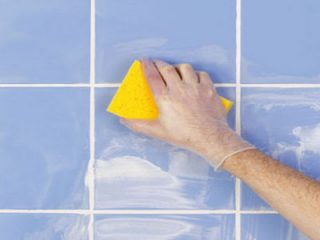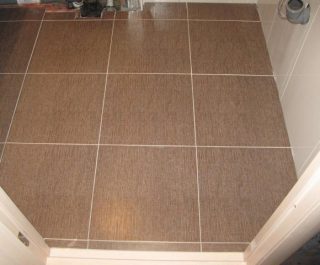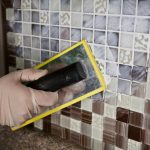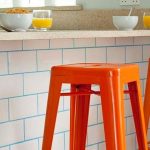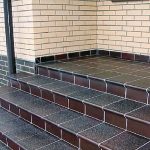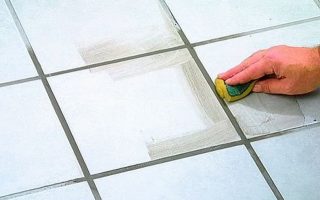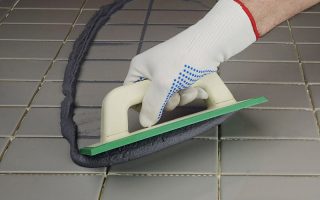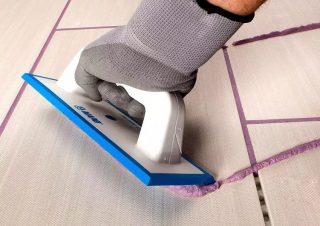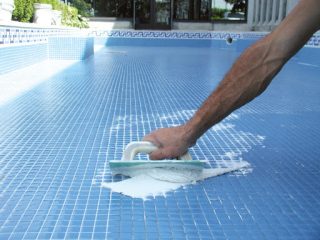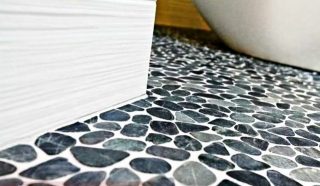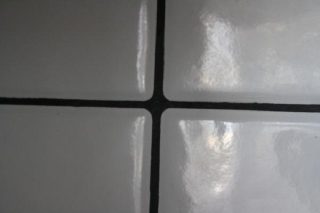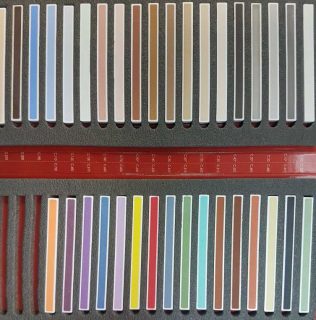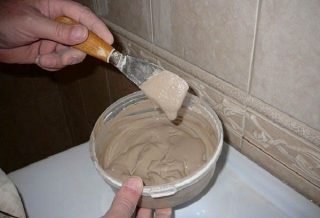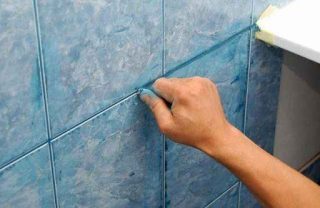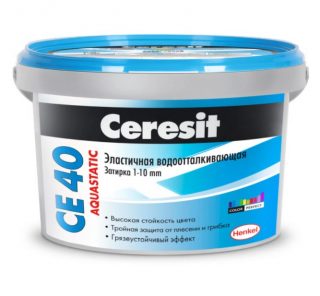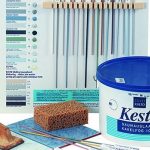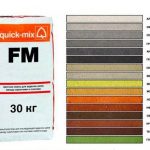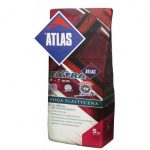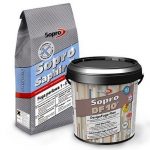When laying tiles and ceramics, you need to fill the joints between the elements, for which a tile grout is used. Correctly selected composition decorates the surface, prevents water penetration. With the help of a contrasting color, they emphasize the geometric pattern of the tile layout, make the surface homogeneous with a single color.
- Description and material properties
- Scope of application
- Varieties of grout for tiles
- Cement
- Latex
- Epoxy
- Polyurethane
- Silicone
- Silicate
- Furanic
- Criterias of choice
- How to choose a color
- Rules and features of working with grout
- Consumption calculation
- Tools and materials for work
- Preparation of the mixture
- Surface preparation
- Grouting
- Renovation of tile joints
- Cleaning tiles after work
- Popular manufacturers
Description and material properties
The joints are processed for improving performance tile cladding:
- moisture does not get under the tiles, does not destroy the layer from the inside;
- microorganisms that cause mold and blackness do not develop on the surface of the seam;
- visually, the finish looks complete;
- small chips and scratches on the edges of the tiles are not visible.
The material is selected depending on the conditions of use. Different requirements are imposed on formulations for indoor and outdoor use. Air humidity is taken into account, for example, in a bathroom or on the walls of a building near a reservoir.
Scope of application
Scope of grout for joints:
- floor tiles in dry rooms, bathrooms, kitchens, toilets, around and at the bottom of pools;
- ceramic, clinker, concrete, brick-like tiles of steps, terraces, gazebos;
- wall surfaces decorated with tiles, mosaics inside the house in heated and cold rooms;
- external tiled cladding of facades, basements;
- sheathing thermal panels outside the building.
The quality of the facing layer depends on the skill of the tile. However, inaccurate sealing of inter-tile joints and incorrect selection of the composition will negate the results of the work.
Varieties of grout for tiles
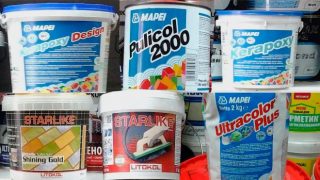
For embedding, they often take homemade compositions of cement and river sand... Such mixtures are short-lived, they have reduced resistance to mechanical damage. Specialized grout for porcelain stoneware, tiles, factory-made ceramics, they contain modifiers that increase the performance of the composition and extend the service life.
The industry produces the following compositions:
- cement-based;
- latex;
- epoxy;
- polyurethane;
- silicone;
- silicate;
- furan.
There are moisture resistant mixtures for use under water, such materials are expensive.At home, take simpler options.
Cement
Features of the compositions cement-based:
- suitable for outdoor and indoor use;
- common for laying tiles on sidewalks, garden paths, in public halls;
- low cost;
- suitability for repair - when cracking, use the same composition.
Cement putties will slowly harden, but this gives time to correct work deficiencies. The solution shrinks significantly when it solidifies.
Latex
Features of grout:
- the seams made with a latex compound never crack;
- have high bending and compressive strength;
- do not respond to sudden changes in temperature;
- retain their characteristics when exposed to atmospheric chemistry;
- do not let water through.
When using, quickly remove the remnants of the mixture and traces on the tiles so that there is no clouding at the point of contact. Steam maintenance is not recommended.
Epoxy
Formulation characteristics based on epoxy resins:
- high-quality sealing against moisture;
- suitable for work under water or in places where moisture can drain;
- used more often for facades and plinths;
- adheres well to wooden elements.
The grouting solution sets quickly, so it is diluted in small volumes. The mixture is viscous and difficult to apply. Quality epoxy putties for ceramic tiles are expensive.
Polyurethane
The qualities of polyurethane grout:
- the composition is sold ready to work in tubes or small containers; it does not need to be diluted with solvent or water;
- grasps slowly, so there is an opportunity to remake sloppy places;
- easily washed off if it gets into neighboring areas;
- you can fill in the joints minimum in width or in the case of a seamless option.
The mixture is resistant to water, dirt, chemicals. Bleach can harm the hardened composition. In wide seams, it does not hold well, exfoliates from the edges.
Silicone
Application features:
- after hardening, a glossy seam surface is obtained;
- works effectively in direct contact with water;
- not suitable for wood and metal parts (poor adhesion).
Grouting mixtures with the inclusion of silicone are released acidic and neutral type. The former are cheaper, but less durable. Such compositions have a destructive effect on the metal if ceramics or tiles dock with it.
Silicate
Silicate grout characteristics:
- used in industrial workshops, where there is a high level of gas pollution;
- heat-resistant mixtures equally withstand the action of hot steam and frosty air;
- effectively repel water;
- elastic material adheres well to all types of surfaces.
The hardened seam does not collapse from shock, friction, vibration. Grouting is used in a private house and in industrial premises. The composition is well used inside and outside the building.
Furanic
The main advantages of the material:
- moisture repulsion, low surface porosity;
- elasticity, stretching and compression together with tiles;
- resistance to cracking (does not change during the entire period of work).

Criterias of choice
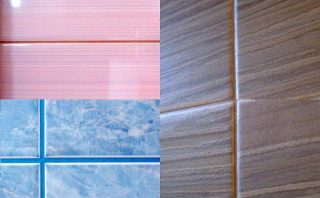
In the estimate for home renovation, the cost of grouting is small, so there is no point in saving on such an important component. High-quality formulations necessarily contain modifiers against fungi, to increase moisture resistance, plasticity, strength.
Pay attention to factors:
- composition - polymer or cement-sand;
- manufacturer's recommended seam parameters;
- material color.
For the treatment of small gaps, mixtures with good adhesion, plastic are chosen. In the mass for filling wide joints, there must be a finely dispersed mineral as a filler. For joints larger than 1 cm, mixtures with a middle fraction filler are used.
How to choose a color
For cement and cement-polymer mixtures, it is better to choose non-marking colors, since they are poorly cleaned of grease and dirt. Compounds that repel dirt, for example, silicone, silicate, epoxy, can even be taken in white.
White color scheme always has an elegant look, therefore it is compatible with different colors. The color of the joint sealant is chosen to match the base coat or made completely contrasting. The sparkle seam works well on dark surfaces.
Rules and features of working with grout
Before work, they prepare the seams for work, acquire the necessary tools.
Tile grout includes stages:
- adding water or solvent to the dry mixture, mixing;
- treatment of seams before application;
- applying mortar to the seam.
The excess is removed immediately so that they do not have time to harden.
If a tiles without glossy finish, some tinted mixtures can stain the surface (check before use). Use masking tape, which is glued on the sides of the seam. Otherwise buy special liquid, with which the edges of the joint and the plane next to the joint are processed. The product forms a film. The mass is applied in a layer, and the film is removed later along with the excess.
Consumption calculation
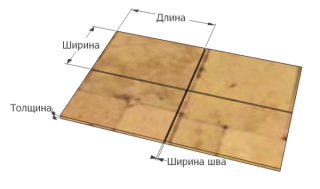
The parameter depends on many factors, therefore, it is necessary to determine the amount of material accurately. For small elements, more composition will go, large tiles will require less mixture. Ideally, calculate the length of the butt joints.
Factors are taken into account:
- the size of the tiles;
- the depth and width of the seam.
One of the sides of the site is divided according to the size of the tile (the side that will be along the line), and the number of seams is considered.The resulting value is multiplied by the length of the second side of the section to obtain the total length of the joints.
Measure the width and depth of the seam, multiply them - get the cross-sectional area. The result is multiplied by the total length of the joints. By default, 1 cubic meter decimeter of the seam is 1.8 kg of grout. Multiplying the volume in cubic decimeters by the rate of the sealant, the grout consumption for the tile is obtained.
Tools and materials for work
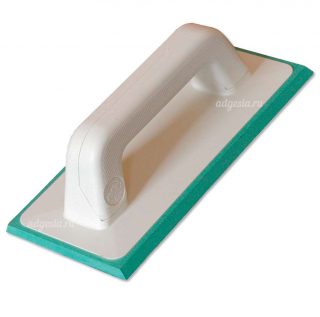
Grout is applied special spatula made of rubber, plastic... Do not use a metal tool because it is too hard. For viscous compositions, a harder rubber is used.
Other tools:
- drill with a whisk for stirring;
- capacity;
- brush, knife, sponge;
- grater with fine emery;
- a vessel with clean water.
They put on gloves on their hands, protect their eyes with glasses.
Preparation of the mixture
Sometimes it is necessary to dissolve two packs of dry mixture at once, for example, cement, which does not set quickly. In this case, it is better to mix them together before adding water. Different packages may have a different shade, which will be noticeable over a large area of the wall or floor. After the first use of the whisk, wait 10 minutes, then the mixture is stirred again.
Surface preparation
Fill in the gaps after laying the tiles every other day, at least. Professionals advise to wait 4-7 daysso that the effects of shrinkage of the tile adhesive are visible.
Docking surface preparation rules:
- take out marking crosses from the gap between the elements;
- debris and dust from the seam is removed with a brush, glue - with a sharp knife;
- the void in the joint is controlled with a spatula, it is necessary that it fits the thickness of the tile.
Cement, polymer-cement compositions require pre-wetting before application, epoxy, furan, silicate are placed on a dry base.
Grouting
Features of grouting flat surfaces:
- the mixture is taken with a spatula, applied to the seam, leveled;
- the area of simultaneous processing should not exceed 1.5 - 2.0 m;
- after setting with a damp sponge, smooth the seam in a circular motion.
For fillet welds the composition is chosen elastic, since the planes of both walls may differ in shrinkage, cracks are possible. In this place, a spatula and a sponge will not help much, so the craftsmen align the seam with their finger, drawing along the line several times. The outer corners are treated with a rubber trowel.
For seamless styling tiles (joint 0.5 - 1.5 mm) are more often used with cement compositions. The spatula is moved diagonally to the line, trying to impose a mass with a slide. After drying, the excess is removed in the transverse direction. The laborious process is best tried on a small part of the wall.
Renovation of tile joints
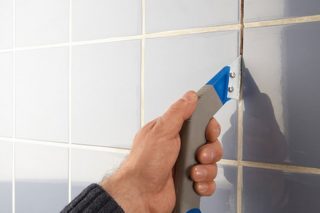
The work is performed by a special with a stitcherwhich removes the old mortar from the joint. If the site is small, the tool is not bought, a knife is used.
First, they pass along the seam, keeping the blade at a right angle. Then the cleaning is repeated two more times already at an angle, tilting the first time in one, then in the second direction. Try not to damage the tile edges. The residues are removed additionally, after which a vacuum cleaner is used to pull out small pieces.
Cleaning tiles after work
The dry and wet method is used.
For dry method take a rag if the tile is glossy. For corrugated tiles, use a trowel with a rubber nozzle or a toothbrush. The tool is moved diagonally to the joining line, making sure that small stones do not fall into the not yet frozen seam.
First stage wet processing carried out immediately after the application of the mass, the second - the next day.The foam sponge is soaked, the entire surface is wiped after the lining. When flaws are identified, they are immediately corrected. On the second day, the surface is polished with a rag.
Popular manufacturers
Main product Kesto (Finland) - cement-based joint compound, suitable for indoor and outdoor use. There are 26 colors to choose from, joint width - 2 - 6 mm, various packaging options.
Quik-miks (Germany) makes dry grout mixtures that are diluted before work. There are packages ranging from 0.5 kg to 5 kg. Quality and cost are in a reasonable combination.
Atlas produces a wide range of dry mixes for finishing, insulation. There are varieties of all polymer, epoxy, cement grouting mixtures. Antifreeze compounds are popular.
Sopro (Germany) produces grout for tile joints outside buildings. There is a category of glitter compositions. You can purchase a tool to apply and remove old putty.

